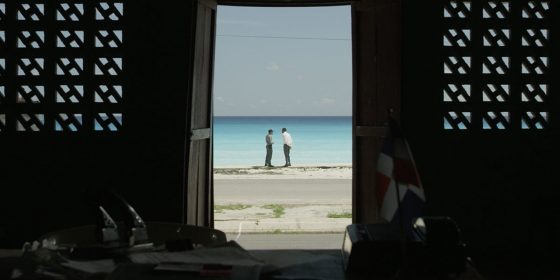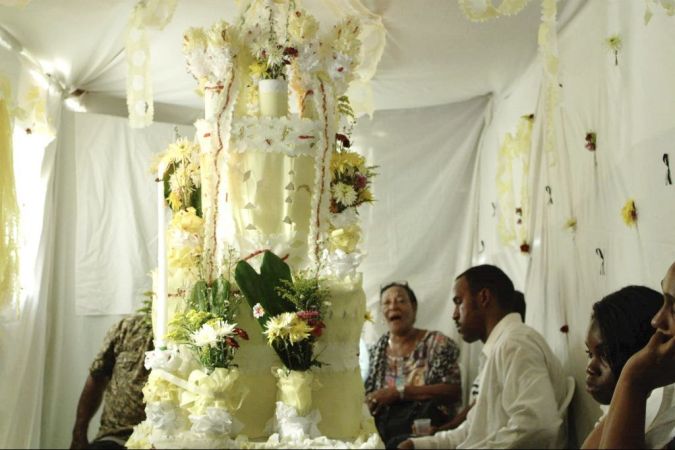Nelson Carlo de los Santos Arias‘ Cocote was that rare film from the Dominican Republic to make the international film festival rounds. On paper, this DR-set film is a revenge film: Alberto (Vicente Santos), a kind-hearted gardener returns home to attend his father’s funeral. When he finds out his father was killed by a prominent local figure, he realizes he’s been summoned to avenge his death. But Alberto is an avowed Evangelical Christian who refuses to even contemplate that kind of action. In de los Santos Arias’ hands, though, the film is a lot more prismatic. With an avant-garde gaze that mixes formats and film ratios to disorient the viewer as we visit a zealously religious community, Cocote showcases the beauty of this island and makes us witness to a story and a people often invisible in global cinema.
Having been submitted by the country for the Foreign Language Film Oscar this year, Cocote clearly signaled a great talent in the making. Remezcla sat down to talk with de los Santos Arias to dissect this most enthralling of films. Check out highlights from our chat with the Dominican director, which ran the gamut from using nonprofessional actors and staging a kind of essay film to the DR’s colonial history and its mulatto roots.
Tell me a bit about how you decided to structure this film, with these chapter breaks throughout.
I am working to structure my films so that they become a Dominican conversation. And a Dominican conversation is going to be a little bit more chaotic. It’s going to be pretty far from the idea of “correct Spanish.” So by analyzing my orality, linguistically speaking, I am also thinking of how I am going to construct films or stories.
There’s chapters that aren’t chapters at all, just messages. There’s this idea of pastiche that I have in the film, where it’s also kind of an essay film. It’s a narrative, but people think it feels like it’s a little bit documentary. For me, I don’t separate it like that. It’s in the way that my mind works, and also it’s a way to organize my thoughts a little bit.

Can you explain the specific faith we see depicted in the film? How is it specific to the Dominican Republic, this mixture of religion and syncretism?
I am not an academic, I’m not an ethnographer, so I cannot know how this manifestation happens in Cuba, or in Brazil with the Candomblé. The only thing I can tell you that’s quite interesting is that Dominican Republic is, in a sense, a very mulatto country. And when I say mulatto, I can also put the word syncretic next to it. With Candomblé or Orishas in Cuba, they’re conscious that this is syncretism. In the Dominican Republic, this idea of syncretism doesn’t exist. So the idea that Africa is part of this construction, of this myth, of these religions, of these rituals — Africa, it’s not there [to them]. It’s invisible. For them, this is Catholicism. Pure and simple. So this is the difference that I’ve seen – it’s less intellectualized in the way that it is in Cuba, or in Haiti or other parts of the Caribbean where they’re proud of their African descendants, or where Africa is more present in their society. Here, it’s gonna be more invisible. Because of racism. Because of the way that colonialism happened, whatever. It’s not my job to think about [why] these things [happened]. My job is to represent how these things are happening.
The film has been compared to a documentary. It has a very authentic feel. Can you walk us through the process of shooting it to get that to come through?
I refused to actually go to a real rezo and shoot. It didn’t feel right. I’d [be] using the suffering of the relative of someone who died to benefit my film. And I said, “No, I have to bring these people, we have to recreate this, and they have to get paid.” But it has to be staged by them, and it has to be organized by them. So the altar, it’s made by them, and I’m just following. None of the protagonists are professional actors. For example, Patria, Yuberbi, the big sister who has the fight in the river, she’s not an actor at all. She’s someone from the community. So yeah, I think the challenge was to make the professional actors be part of this, and have them not feel like actors — and for that, I worked a lot.

There are a handful of moments where you mix in real news footage — some of it quite ridiculous — into the film. What was the purpose behind these intrusions of real life TV in the film?
Most of our countries are colonized by television somehow. I mean, in a place like Dominican Republic, where not a lot of people go to the cinema or there’s not a lot of films, television is going to become the media where they are seeing themselves represented. And I wanted to use those programs that are related to religious events, those television programs that are famous over there. (In certain social classes, not the upper class. And even to the middle class it seems ridiculous.) But to that guy a rooster sings to, it’s real. This is another way that religion manifests itself in the Dominican Republic. Television becomes a way of expressing it.
And that speaks to the way you’re telling this story. It’s rooted in the country’s own formats.
This is the way I’m making films right now. If we are fighting to destroy hierarchies or institutions, if we want to attack the paradigms of production of knowledge, we also have to attack our media itself. And my media is cinema. So this is something that I get really mad about sometimes with directors in Latin America [who] want to do political films, but use the mode of representation of an action film. And like, what the hell are you doing? What are you doing? You think cinema is that model of representation, that it’s already racist, and so you’re not even trying to find a way? It’s like, for example, when people are trying to translate or import the feminism, the mainstream feminism or queerness or whatever from the United States to apply in this society: the configuration of a woman, the configuration of a gay man in Santo Domingo and Mexico is completely different from New York. You cannot — from an Anglo-Saxon, Protestant, white society — you cannot analyze the configuration of those things. So this same thing happens to cinema. I cannot talk about real issues in the Dominican Republic through an action movie from Hollywood, because Hollywood never cared about representing Mexicans or representing black people or representing any minority. So I’m not using their mode.
That strikes me as quite radical, especially because you’re pushing back against this idea that cinema is only from Europe or the United States, when there’s so obviously so many other strands — Cinema Nouveau, Third Cinema — from around the world. Where did you come to these ideas?
It was a little bit of my own. I had to go to the United States a little bit to learn about these things. I went to a very prestigious film school in Buenos Aires, which is a quite complicated city for cinema, because I have a lot of problems with Argentina. In terms of how they’ve played the card of the white intellectual in Latin America. But in Europe, they play the card of Latin Americans. So I have a lot of problems with them. I went to film school there and to be pragmatic in that answer, in five years, I had maybe three or four classes about Glauber Rocha. And then the Nouvelle Vague, the French New Wave.
But not the Brazilian New Wave.
No, no, no. Cine Imperfecto Cubano? Never. I had to go to Cal Arts to learn about these things. To me, Billy Woodberry and Charles Burnett, part of the LA Rebellion, they were the ones who started teaching me for real about Latin American cinema. They love Latin American cinema. They know so much about it. And these kids, making horrible films in Latin America thinking that they are Rohmer or Bresson. Like, come on!
This brings me to an interesting question because I think a lot of Latin American cinema that’s being made today is not necessarily reflecting all the ideas that are out there. It’s just what’s able to be funded.
Of course, of course. There’s a brand. My films were so cheap that I think it’s a good question if I start making films a little bit bigger, how difficult it’s going to be. It’s quite interesting what happened with Cocote because somehow, yes, it’s quite experimental, it’s a weird film. But at the same time, it’s dealing with a topic that is very intrinsic to the society. People started to say, ‘This is the most Dominican film that I’ve ever seen.’
In that sense, in the beginning it was super hard to find any money. But yes, going to the business people, like I’m making this film about this community in Villa Mella — black people, like that — it was a little bit complicated for them. But then the film has been successful internationally, so for them it now becomes more like a national pride. They’re proud of the film! Like oh, man, this kid’s first film is in an A-class festival like Locarno. So for them it was quite interesting, and internationally speaking, I guess it helped me that it was a Dominican film; there’s not a lot of Dominican films.
This interview was conducted by Vanessa Erazo




